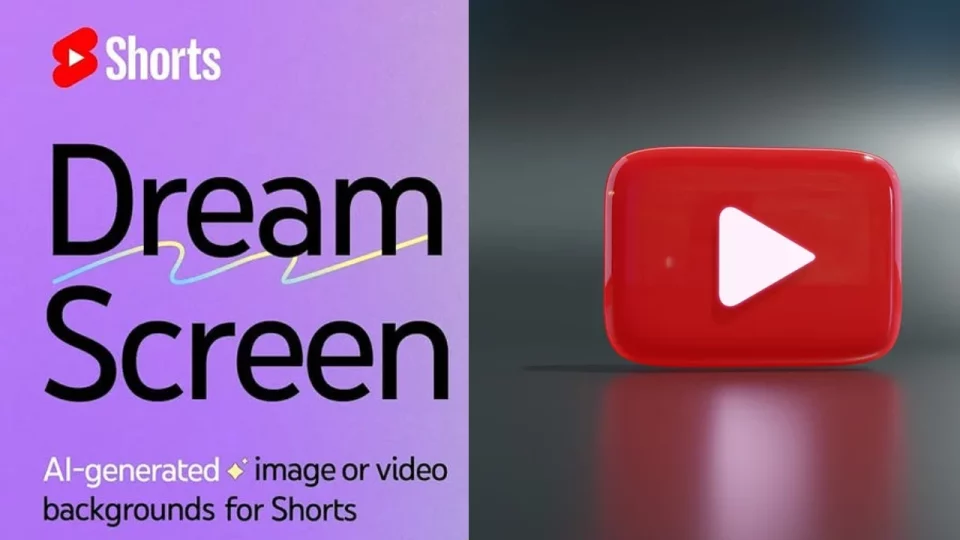In a significant technological advancement, YouTube has taken another step in revolutionizing short-form content creation with its upgraded AI-powered Dream Screen feature. Introduced initially as a tool for generating image backgrounds, Dream Screen now includes the ability to create AI-generated video backgrounds for YouTube Shorts.
This enhancement not only expands creative possibilities for content creators but also showcases Google’s growing influence in artificial intelligence through its Veo AI model.
Table of Contents
🟣 New Creativity with Dream Screen
Launched as an experimental feature, Dream Screen’s new capability to generate video backgrounds elevates its utility from a novelty to a potentially transformative tool for creators. The addition of video generation allows users to experiment with dynamic visual environments that can set the tone and mood of their content like never before.
Dream Screen empowers creators to:
- Unlock Imagination: By simply typing a text prompt, creators can describe the background they envision—whether it’s a tranquil beach at sunset, a bustling cityscape, or an abstract animation—and the tool brings it to life in video form.
- Reduce Production Costs: High-quality backgrounds previously required expensive equipment or production resources. Now, creators can access visually compelling content without needing a studio or professional editing tools.
- Expand Accessibility: Dream Screen lowers the entry barrier for aspiring creators, enabling them to produce professional-looking content with minimal investment.
The feature currently supports six-second video clips, which are seamlessly integrated into the vertical video format of Shorts. This length aligns with the quick, engaging content style that has made Shorts a popular competitor to platforms like TikTok and Instagram Reels.
🟣 The Technology Behind Dream Screen: Veo AI Model
At the heart of Dream Screen lies the Veo AI model, a cutting-edge video generation system developed by Google’s DeepMind. This model is designed to interpret textual prompts and generate corresponding video outputs with remarkable accuracy. While AI-generated images have gained widespread attention over the past few years, creating video content from text is a more complex challenge due to factors like motion consistency, visual coherence, and contextual understanding.
Key Features of the Veo AI Model
- Contextual Understanding: The AI model interprets nuanced prompts to deliver backgrounds that align with the creator’s vision.
- Motion Dynamics: Unlike static image generation, video generation requires AI to simulate realistic movements and transitions within the scene.
- Safe Content Generation: Veo AI incorporates safeguards to prevent inappropriate or harmful content, aligning with YouTube’s Community Guidelines.
While still experimental, the early feedback suggests that Veo AI could pave the way for more sophisticated AI-driven content tools in the future.
🟣 Current Availability and Future Prospects
As of now, the Dream Screen feature is only accessible to a limited number of creators in select regions, including Australia, Canada, New Zealand, and the United States. YouTube has not yet announced a timeline for a global rollout, but its strategy to test the feature with a specific audience reflects the platform’s cautious approach to deploying innovative technologies.
Challenges to Address
While the potential of Dream Screen is immense, YouTube faces several challenges before making the feature widely available:
- Language Limitations: Currently, Dream Screen only supports English-language prompts. Expanding support for multiple languages will be crucial for a global audience.
- Ethical Concerns: Safeguards against generating deepfakes or offensive content need to be robust, as AI-generated media poses ethical and legal risks.
- Accessibility Barriers: Limiting the feature to a handful of regions may frustrate creators in other parts of the world who wish to experiment with the tool.
Despite these hurdles, YouTube’s track record of iterative improvements suggests that Dream Screen will likely evolve into a more inclusive and feature-rich tool in the near future.
🟣 How Creators Can Use Dream Screen
For creators fortunate enough to have access to the experimental feature, using Dream Screen is a straightforward process. Here’s a step-by-step guide:
- Open the YouTube App: Launch the app on your mobile device.
- Access the Create Section: Tap the “Create” button to start the process.
- Select Green Screen: From the right-side menu, navigate to the Green Screen option.
- Input Your Prompt: Use the text field to describe the image or video background you need. For instance, you might type “a futuristic city with flying cars” or “a serene forest with flowing waterfalls.”
- Generate and Record: Tap “Create” to generate the background and then start recording your video using the generated backdrop.
This intuitive workflow ensures that even beginners can experiment with AI-generated content without needing prior technical expertise.
